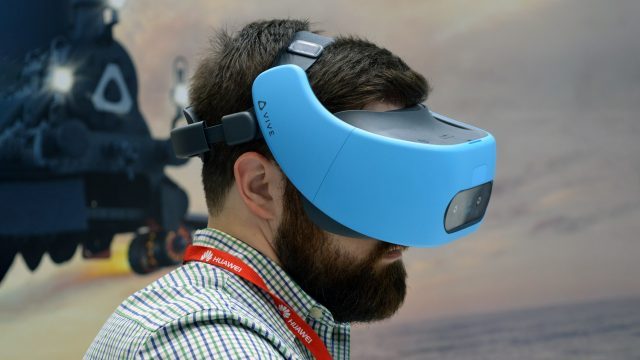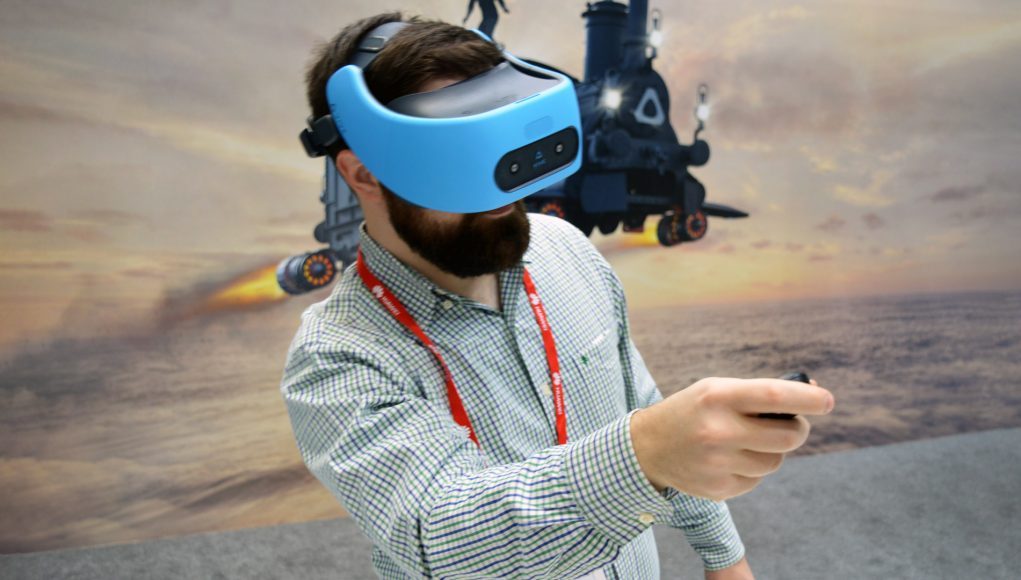Mobile-class Graphics
Of course, to make use of display and lens capabilities, you need the rendering power to back it up. For well optimized experiences, like the headset’s ‘home’ menu, you could see the difference the added resolution makes. With the headset fundamentally reliant on mobile hardware for rendering, the graphics simply can’t stand up to what’s possible on a tethered headset connected to a high-end gaming PC. The one game I had a chance to play (a cover shooter) didn’t feel like it was rendered and textured well enough to really make use of all the pixels available. That, of course, will come down to developer competency in the end, but one would hope that there’s premium content to match what HTC says is the premium choice among standalone headsets.
Vive China President Alvin Wang Graylin told me however that, thanks to an 8K video player available on the Vive Focus, video playback fidelity between the Focus and the Vive Pro is essentially matched. That could make the Focus a great headset for 360 and VR video, but there’s still a long way to go when it comes to fostering a library of strong video content for VR headsets, and making it readily available.
Ergonomics

HTC has designed a headband which uses both a semi-rigid over-head strap and a rigid behind-the-head strap which has a tightening knob. The weight distribution of the headset feels quite near to your face, and the straps do a good job of keeping it from swaying, so your twisting and turning it doesn’t feel as much like you have a brick hanging from the front of your face. It’s also quite easy to put on. I was pleasantly surprised with the comfort of the Focus, at least for my initial hands-on time with it, but it’ll take a longer session to really get a feel for long-term comfort.
Premium + Casual = ?

There’s still the question of price and exactly who the target market is for such a headset. Even with Lenovo’s Mirage Solo, which the company intends to price “less than $400,” I had the same questions. With the Vive Focus, which we’d expect to launch in the US at around $525 (based on the exchange rate), the problem is compounded. It’s a VR headset for casual users, but I simply don’t know a lot of casual users who would drop $500+ dollars on a gaming device.
At least in my own experience, the only people I know spending that kind of cash for gaming are all hardcore gamers playing on either a game console or PC, which means they are quite likely to already have hardware capable of running a less expensive PC or console VR headset that’s capable of a higher fidelity experience with much better graphics. And if they don’t own a VR capable PC or console already, but still want some VR in their life, the $200 Oculus Go might sound more reasonable to casual users compared to a Vive Focus priced around $525.
Graylin argued that the kind of consumer who might buy a Nintendo Switch would be a good candidate for the Focus, given the headset’s portability, ease of setup (thanks to no need for external beacons), and therefor ease of sharing. He said it’s compact and easy to carry in a bag, which makes it readily available for killing 20 minutes here or there. He touted the quantity and price of VR content on Focus as a plus, compared to $60 games on Switch, but it’s my feeling that one great $60 game (something closer to a ‘killer app’) converts buyers at a much greater rate than even 100 decent $1 games; Graylin shared his thoughts with us about VR’s missing killer app last year.
Graylin also pointed to some of the headset’s other use-cases, like web browsing and social communication (like being able to hang out with friends in Bigscreen, he said, which is soon due out on mobile platforms), which add to the value proposition.
– – — – –
Ultimately the market will decide if there’s a place for a standalone VR headset like the Focus that’s priced the way it is, a question which is likely to be greatly influenced by the timing of the headset’s broader rollout, and what Oculus has planned for its own premium standalone headset, Santa Cruz.







